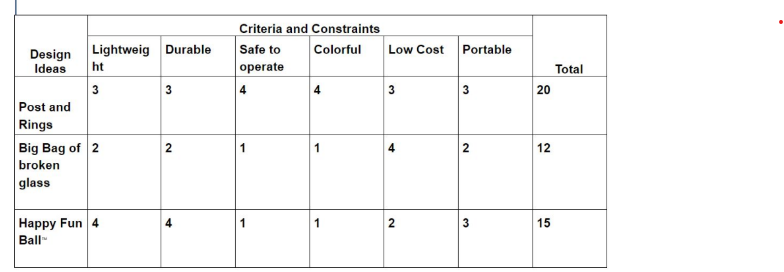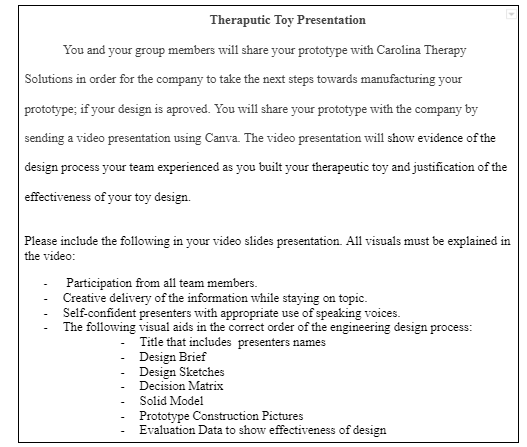
Therapeutic Toy Design
Jerrin Martus
Design and Modeling Class
PBL Scenario Video, Click to the Right
back to top
Therapeutic Toy Design Formative Assessments
Gimkit Formative Assessment
One of the formative assessments used during this unit is a Gimkit. The Gimkit is a digital gamified quiz type of formal assessment used to view if students have an understanding of cerebral palsy and the design requirements to build their therapeutic toy prototype. Gimkit allows immediate reflection of a student's understanding of cerebral palsy and the design requirement to proceed on to the next stages of the unit. The Gimkit consists of thirteen questions, the link for the Gimkit is: https://www.gimkit.com/view/6383a7e40dc6e80021f1b8e0
Decision Matrix Formative Assessment
Another formative assessment used in this unit is a decision matrix. The decision matrix will help students, within their groups, formulate ideas for their toy design. Students will use this formative assessment to reflect on which design the individual group members developed is the best For the Group to design to build. The teacher will use this formative assessment to see if student groups need help with choosing a design to build and if their toy design is appropriate to build.
Sample Decision Matrix for Therapeutic Toy Design
There are three toy designs and students evaluate which one is the best to build.

Summative Assessment
For the final part of the therapeutic toy design unit students will create a presentation to share with the Carolina Therapy Solutions office, which employs occupational therapists who provide therapy to children using toys.
Task Prompt is Below

Summative Assessment Rubric
Click to view the entire rubric
Therapeutic Toy Design Presentation Rubric
Names
Criteria
Design Brief (10 points)
Design Sketches (10 points)
Decision Matrix (10 points)
Solid Model
Basic
Proficient
Advanced
Self Evaluation
The design brief is incomplete and multiple components are inaccurately identified.
Multiview
sketches are
incomplete,
inaccurate, and
not properly
annotated to
show all
important
information.
Little or no design ideas are documented as sketches or notes. The decision matrix
is incomplete or missing. The chosen design solution is not clearly justified using the matrix.
Solid models
The design brief is complete and accurately identifies most components
Multiview sketches are mostly
complete, accurate, and properly annotated to show all important information.
Some design
ideas are
documented as
sketches or
notes. The
decision matrix
is somewhat
complete.The
chosen design
solution is not
clearly justified
using the matrix.
Solid models
The design brief is complete and accurately identifies all components.
All multiview sketches are complete, accurate, and properly annotated to show all important information.
All design ideas are documented as sketches or notes. The decision matrix
is complete and each design
idea is evaluated.The chosen design clearly justified using the matrix.
Solid models
Peer Review
Teacher Comments
Review and Reflection About the Course
From this class, I have learned to create formative and summative assessments during a PBL unit. I have also learned that formative and summative assessments are distinguished by formative assessments occurring during the learning process and summative assessments occurring at the end of the unit. I was able to create two formative assessments that would help facilitate my PBL unit by viewing several examples and understanding that formative assessments are used to provide both students and teachers with opportunities for reflection on the progression of the unit. I understand how valuable formative assessments are to ensuring that students get to the end goal of their project, even though they often do not count as a grade.
I have learned the importance of ensuring that summative assessments are relevant and authentic for students during a PBL unit. I also understand the effectiveness of using a rubric for a summative assessment. Using the rubric I can better evaluate student's mastery of each objective I set for students prior to the unit. The rubric makes the evaluation clear and concise for students to review their strengths and weaknesses.